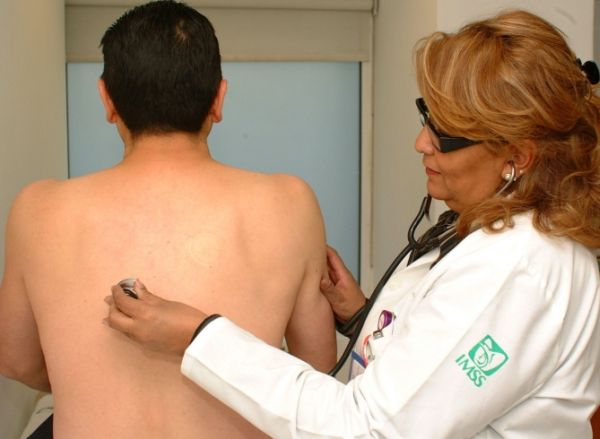
Tuberculosis or TB is an infectious disease that affects your lungs. The bacteria responsible for the disease spread from one person to another through the tiny drops that are released into the air when the infected person sneezes or coughs. In developed countries, tuberculosis was rarely seen. But after 1985, the number of TB patients began to increase. The increase was due to the advent of HIV, a virus that is responsible for AIDS. This virus weakens the immunity system which makes it prone to the TB organisms. Some of the drugs that are used most commonly to treat TB have no effect on many strains. So the patients suffering from this disease have to take a lot of medications together to combat the disease and prevent antibiotic resistance developed by the bacteria.
Causes
TB is caused by Mycobacterium tuberculosis when it is spread by airborne particles. The infection is passed from one affected person to another. When the infected person sneezes, coughs or talks, small droplets of mucus are let out into the air and is inhaled by the person close by. The disease causing bacteria is transmitted to the blood stream and lymphatic system which then spreads to other organs of the person.
Other risk factors for tuberculosis include low socio-economic status, HIV infection, alcoholism, poor living conditions, homelessness, ailments that weaken the immune system and migrating from areas with many TB cases.
Symptoms
Even if your body has the bacteria, the immune system prevents you from becoming sick. So the doctors have to distinctly find the differences between Latent TB and Active TB.
Latent TB is a condition where you are infected with the TB bacteria but they remain inactive and show no symptoms. It is also known as inactive TB or sometimes TB infection. This stage is not contagious.
Active TB is when you are infected, sick and spread the germs to others. This stage occurs within a few weeks of the infection with the bacteria. Sometimes it may take even years to become active. Many people who are infected with the TB bacteria do not develop active TB.
Symptoms of TB include cough, unexpected weight loss, fever, fatigue, chills, night sweats and loss of appetite. This disease usually attacks the lungs. Sings that show TB of lungs include coughing up blood, coughing for three or more weeks, chest pain or pain while coughing or breathing. Even other parts of the body can be affected by TB like brain, kidneys and spine. The symptoms of each type of TB are different too. When you have TB in the spine you may experience back pain. If the kidneys are infected there may be blood in the urine. If you have fever and unexplained loss of weight, persistent cough and drenching sweats at night you have to consult your doctor immediately. He may perform various tests to identify the cause.
Diagnosis
The doctor will perform various tests to identify the disease. He may check the lymph nodes to see if they have ant swellings. He may use the stethoscope and listen to the sounds in your lungs while breathing.
1. Skin test
The tool most commonly used for diagnosing TB is a simple test on the skin. A substance called PPD tuberculin will be injected inside the forearm just below the skin. You may feel only a slight prick. After about 48-72 hours, the doctor will take a look at the area where the injection was given. If there is a hard red and raised bump, then you are infected with the TB bacteria. The bump size determines the significance of the test results. This test may not provide exact results.
2. Blood tests
Blood tests are used for confirming latent or active TB. They use sophisticated devices and technology to measure the bacteria’s response to the immune system. The tests are useful for high-risk of TB.
3. Chest X-ray
When you get a positive for the skin test you may have to take a chest X-ray. It shows the white spots in the lungs where the immune system prevented the bacteria.
4. Sputum tests
If the X-ray reveals signs of TB you may need to do the sputum test. A sample of your sputum is taken for testing for the presence of the bacteria. It can also be tested for knowing the resistance of the bacteria to the medications. The test results help the doctor to choose the treatment for you.
Treatment
When compared to other types of bacterial infections it may take quite long for curing TB. You need to take antibiotics for over 6-9 months. The type of medications and the duration of the treatment depend on various factors like your age, resistance level, overall health, location in the body and form of the TB (active or latent).
If you are diagnosed with latent TB you should take one type of medication. For active TB with the drug resistant strain, you may have to take many drugs simultaneously. Some of the common drugs used for treating TB include Isoniazid, Rifampin (Rimactane, Rifadin), Ethambutol (Myambutol) or Pyrazinamide.
Some people may experience certain side effects while taking these medications. If you experience any of the following symptoms visit the doctor immediately like vomiting, nausea, loss of appetite, yellow skin, dark color urine and fever for more than three days. The most important thing is that you have to complete the treatment prescribed by your doctor. If you skip any part it will allow the bacteria to become drug resistant. So stick to the treatment and get cured completely.




